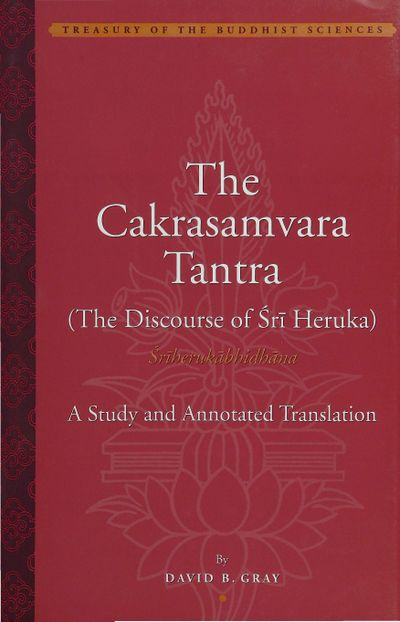Series Editor's Prefaceix Author's Prefacexv
Introduction: The Study of the Cakrasamvara Tantra
- 1. Introduction to the Cakrasamvara Tantra
- The Cakrasamvara and the Yoginī Tantras3
- Dating the Text11
- Cakrasamvara Literature 15
- 2. Traditional History of the Cakrasamvara Tantra
- Mythic Root Texts28
- The Origin of Heruka35
- 3. Contents and Contexts
- The Triple Wheel Mandala54
- Ḍākinīs, Yoginīs, and Women77
- Consecration and the Sexual Yogas103
- Mantras and Magic131
- 4. Texts and Translation
- Texts Employed137
- Translation Methodology145
- Technical Notes151
Translation of the Cakrasamvara Tantra
- I. The Descent of the Maṇḍala155
- II. The Procedure of Wheel Worship164
- III. The Procedure of Consecration and Fee [Payment]171
- IV. The Procedure Called 'The Nonduality of the Heroes and Yoginīs'178
- V. The Procedure of Selecting the Letters of the Root Mantra181
- VI. The Procedure of Selecting the Hero's Six Armor [Mantras]186
- VII. The Procedure of Selecting the Mantra188
- VIII. The Procedure of Selecting the Reversed Yoginī Mantras194
- IX. The Procedure of the Ritual Actions of the Root Mantra196
- X. The Achievement of the Triple Body and the Procedure of the Ritual
Actions of the Essence Mantra202 - XI. The Procedure of Characterizing the Seven-lived One206
- XII. The Procedure of the Ritual Actions of the Quintessence209
- XIII. The Procedure of the Applications of the Armor Mantra214
- XIV. The Procedure of the Donkey Form Yoga for Becoming Śrī Heruka217
- XV The Procedure of the Syllabic Signs222
- XVI. The Procedure of Examining the Characteristics of the Seven Yoginīs226
- XVII. The Procedure of the Signs, Gestures, and Perambulant Forms of All
Yoginīs232 - XVIII. The True Procedure of the Colors, Characteristics, and Signs of all
Yoginīs236 - XIX. The Procedure of Pointing Out the Gestures of the Yoginīs239
- XX. The Procedure of the Symbolic Hand Gestures of the Yoginīs243
- XXI. The Procedure of the Characteristics of the Visual Body Gestures246
- XXII. The Procedure of the Characteristics of the Distinctive Limb Gestures248
- XXIII. The Procedure of the Characteristics of the Ḍākinīs' Signs and Insignia250
- XXIV. The Procedure of the Symbolic Speech of the Four Classes256
- XXV The Procedure of Completely Hiding the Root Mantra263
- XXVI. The Procedures of Inspecting the Disciple and the Vows265
- XXVII. The Procedures of the Conduct, Observances, Worship, and Sacrificial
Cakes271 - XXVIII. The Procedures of the Inner Fire Sacrifice and Class Oneness282
- XXIX. The Procedures of the Messenger's Defining Marks and the State of Empowerment289
- XXX. The Procedure of Mantra Selection Bound in the Muraja Drum292
- XXXI. The Procedure of the Rites of Eating, Fire Sacrifice and the Sacrificial
Cakes, and the Hand Signs297 - XXXII. The Procedures of the Animal Sacrificial Victims, the Means of
Achieving the Zombie, and the Creation Stage300 - XXXIII. The Reverential Procedure of Secret Worship305
- XXXIV. The Procedure of Summoning via the Fire Sacrifice of the Nondual
Messenger308 - XXXV. The Procedure of the Nondual Ritual Action and the Method of
Cheating Black Death312 - XXXVI. The Procedure of Summoning the Reality Worship317
- XXXVII. The Procedure of Inner Mastery320
- XXXVIII. The Procedure of the Yoginīs' Place and the Heroes' Secret Abode322
- XXXIX. The Procedure of Vision and Loud Laughter325
- XL. The Procedures of Subjugating the Five Social Classes and Mahāmudrā327
- XLI. The Procedure of Laying Down the Mandala of the Twenty four
Syllables329 - XLII. The Procedure of the Laughter Mantra and the Magic of the Yoginīs'
Forms338 - XLIII. The Procedure of Accomplishing the Ritual Actions of the Quintessence [Mantra]343
- XLIV. The Procedure of the Six Yoginīs' Ritual Actions with the Seven Syllable [Mantra]350
- XLV. The Six Yoginī Ritual Actions and the Summoning of the Power of
Speech353 - XLVI. The Procedure of Ritual Actions with the Five ha Syllables358
- XLVII. The Procedure of All Ritual Actions of the Sarvabuddhaḍākinī
Mantra360 - XLVIII. The Procedure of the Maṇḍala of the Hidden Abode of all Heroes
and Ḍākinīs364 - XLIX. The Procedure of Transforming the Victim who is Born Seven Times367
- L. The Procedure of the Domination Fire Sacrifice and the Teaching of the
Stages in Relation to the Seats, etc.370 - LI. Creation Stage Esoteric Instruction376
- Glossaries385
- Conspectus Siglorum405
- Bibliography409
- Index437


